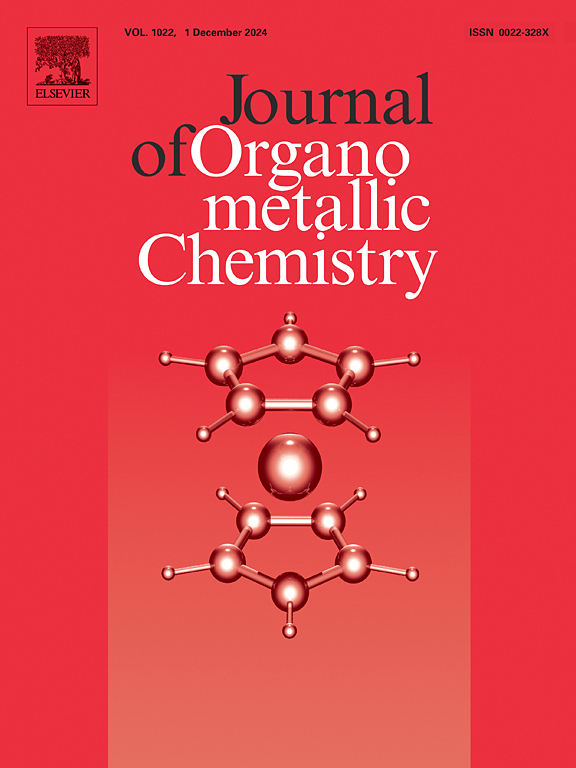亚硝基配合物[M2Cp(μ-κ:η - c5h4)(μ- pr2)(CO)(NO)2]的合成及质子化反应得到κ:η-NO桥接衍生物(M = Mo, W;R = Cy, tBu)
IF 2.1
3区 化学
Q3 CHEMISTRY, INORGANIC & NUCLEAR
引用次数: 0
摘要
标题化合物是由已知阳离子[M2Cp2(μ-PR2)(CO)2(NO)2]+ (M = Mo, W;R = Cy, tBu;Ar′= 3,5- c6h3 (CF3)2),与商业Me3NO·2H2O在273 K的氟苯溶液中,这促进了脱羰基和环戊二烯基去质子化,生成了环戊二烯配体桥接金属中心的配合物(W−W = 2.9917(5) Å,当R = Cy时)。然而,使用二氯甲烷作为溶剂,Mo化合物引发了氯离子的竞争萃取反应,生成了氯离子配合物[Mo2Cp2Cl(μ-PR2)(CO)(NO)2],特别是形成了Cp配体相对于Mo2P平面的反位,羰基和氯离子配体相对于P原子的顺位(Mo−Cl = 2.336(4) Å,当R = tBu时)。当R = tBu时,环戊二烯桥接配合物与[H(OEt2)2](BAr ' 4)发生质子化反应,得到双环戊二烯基阳离子[M2Cp2(μ-κ:η-NO)(μ- pr2)(CO)(NO)]+ (Mo−Mo = 3.1027(2) Å;当R = Cy时,W−W = 3.0446(7) Å),根据密度泛函理论计算,这些亚硝基配体显示出罕见的端对侧对线性配位模式的桥接亚硝基配体,是动力学产物而不是热力学产物。然而,当HBF4·OEt2作为质子化试剂作用于ptbu2桥接配合物时,外部阴离子(以κ1模式)也发生配位,生成四氟硼酸配合物[M2Cp2(κ1-BF4)(μ-PtBu2)(CO)(NO)2]作为唯一(Mo)或主要(W)产物。同样的环戊二烯配合物与[me30](BF4)的甲基化作用仅在钨离子上观察到,并且在一个亚硝基配体的O原子上特异地发生甲基化反应,得到[W2Cp(μ-κ:η5-C5H4)(NOMe)(μ- ptbu2)(CO)(NO)](BF4),该配合物显示线性甲氧基酰配体(W−N = 1.746(4) Å;W−N−O = 163.5(4) O)。本文章由计算机程序翻译,如有差异,请以英文原文为准。
![Synthesis and protonation reactions of nitrosyl complexes [M2Cp(μ-κ:η5-C5H4)(μ-PR2)(CO)(NO)2] to give κ:η-NO-bridged derivatives (M = Mo, W; R = Cy, tBu)](https://img.booksci.cn/booksciimg/2025-2/100297540751769533791.jpg)
Synthesis and protonation reactions of nitrosyl complexes [M2Cp(μ-κ:η5-C5H4)(μ-PR2)(CO)(NO)2] to give κ:η-NO-bridged derivatives (M = Mo, W; R = Cy, tBu)
The title compounds were prepared upon reaction of BAr’4− salts of the known cations [M2Cp2(μ-PR2)(CO)2(NO)2]+ (M = Mo, W; R = Cy, tBu; Ar’ = 3,5-C6H3(CF3)2), with commercial Me3NO·2H2O in fluorobenzene solution at 273 K, this promoting decarbonylation and cyclopentadienyl deprotonation to yield complexes with cyclopentadienylidene ligands bridging the metal centres (W−W = 2.9917(5) Å when R = Cy). The use of dichloromethane as solvent, however, triggered a competitive chloride abstraction reaction by the Mo compounds that yielded the chloride complexes [Mo2Cp2Cl(μ-PR2)(CO)(NO)2], specifically formed with an anti disposition of the Cp ligands relative to the Mo2P plane, and cis positioning of carbonyl and chloride ligands relative to the P atom (Mo−Cl = 2.336(4) Å when R = tBu). Protonation of the cyclopentadienylidene-bridged complexes with [H(OEt2)2](BAr’4) yielded the BAr’4− salts of the dicyclopentadienyl cations [M2Cp2(μ-κ:η-NO)(μ-PR2)(CO)(NO)]+ (Mo−Mo = 3.1027(2) Å when R = tBu; W−W = 3.0446(7) Å when R = Cy), which display bridging nitrosyl ligands in the rare linear end-on:side-on coordination mode, and are kinetic rather than thermodynamic products, according to density functional theory calculations. When using HBF4·OEt2 as protonation reagent on the PtBu2-bridged complexes, however, coordination of the external anion (in the κ1-mode) also takes place, to yield the tetrafluoroborate complexes [M2Cp2(κ1-BF4)(μ-PtBu2)(CO)(NO)2] as unique (Mo) or major (W) products. Methylation of the same cyclopentadienylidene complexes with [Me3O](BF4) was only observed for the tungsten cation, and took place specifically at the O atom of one nitrosyl ligand to give [W2Cp(μ-κ:η5-C5H4)(NOMe)(μ-PtBu2)(CO)(NO)](BF4), a complex displaying a linear methoxyimido ligand (W−N = 1.746(4) Å; W−N−O = 163.5(4)o).
求助全文
通过发布文献求助,成功后即可免费获取论文全文。
去求助
来源期刊

Journal of Organometallic Chemistry
化学-无机化学与核化学
CiteScore
4.40
自引率
8.70%
发文量
221
审稿时长
36 days
期刊介绍:
The Journal of Organometallic Chemistry targets original papers dealing with theoretical aspects, structural chemistry, synthesis, physical and chemical properties (including reaction mechanisms), and practical applications of organometallic compounds.
Organometallic compounds are defined as compounds that contain metal - carbon bonds. The term metal includes all alkali and alkaline earth metals, all transition metals and the lanthanides and actinides in the Periodic Table. Metalloids including the elements in Group 13 and the heavier members of the Groups 14 - 16 are also included. The term chemistry includes syntheses, characterizations and reaction chemistry of all such compounds. Research reports based on use of organometallic complexes in bioorganometallic chemistry, medicine, material sciences, homogeneous catalysis and energy conversion are also welcome.
The scope of the journal has been enlarged to encompass important research on organometallic complexes in bioorganometallic chemistry and material sciences, and of heavier main group elements in organometallic chemistry. The journal also publishes review articles, short communications and notes.
 求助内容:
求助内容: 应助结果提醒方式:
应助结果提醒方式:


